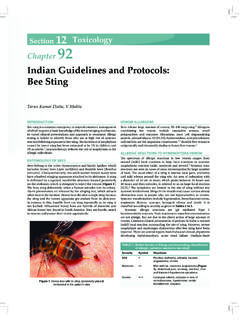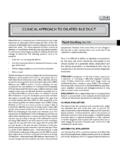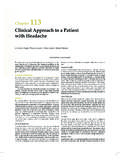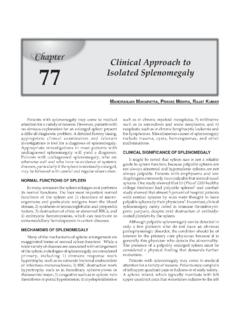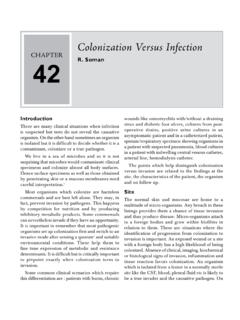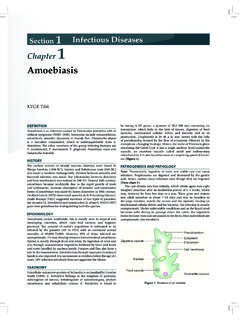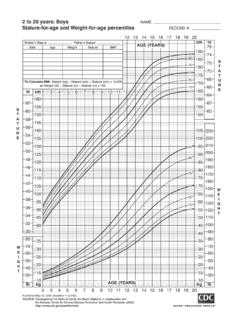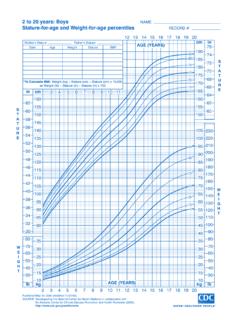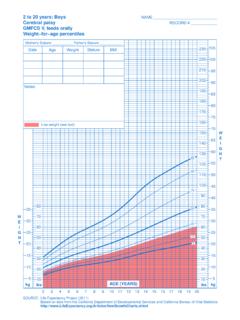Transcription of Chapter 137
1 Cases. In a study to evaluate prevalence and etiological profile of short stature in children attending out patient department (OPD) of a community-level hospital, the prevalence of short stature was ; significantly higher than prevalence reported from tertiary centers. The most common cause of short stature was PEM and chronic diseases occurring in cases. Other causes included normal variant short stature , endocrine problems and miscellaneous could not be classified due to loss to follow-up and inability to refer to tertiary OF SHORT STATUREP roportionate Short StatureNormal Variants (Table 1) Familial Constitutional delay in growth and Causes Intrauterine growth restriction (placental, infections or teratogen) Genetic disorders (chromosomal and metabolic disorders).
2 Postnatal Causes Under nutrition Chronic systemic illness Psychosocial short stature (emotional deprivation) Endocrine causes Growth hormone deficiency/insensitivity Hypothyroidism Juvenile diabetes mellitus Cushing s syndrome Pseudohypoparathyroidism Precocious/delayed Short StatureWith Short Limbs Achondroplasia, hypochondroplasia, chondrodysplasia punctata, chondroectodermal dysplasia, diastrophic dys plasia, metaphyseal chondrodysplasia Deformities due to osteogenesis imperfecta, refractory Short Trunk Spondyloepiphyseal dysplasia, mucolipidosis, mucopoly saccharidosis Caries spine, stature : Evaluation and ManagementPreetam Nath, Jitendra Kumar, SK Hammadur Rahman, Madhukar RaiINTRODUCTIONS hort stature is defined as height below 3rd centile or less than two standard deviations (SDs) below the median height for that age and sex according to the population standard; or even if the height is within the normal percentiles but growth velocity is consistently below 25th percentile over 6 12 months of ,2 Approxi mately 3% children in any population will be short, amongst which half will be physiological (familial or constitutional) and half will be pathological.
3 Normal growth requires adequate nutrition along with various hormonal stimuli. The important hormones are: growth hormone (GH), insulin like growth factor (IGF) 1, thyroid hormones, sex steroids and other growth factors. Linear growth is maximum during infancy; 25 cm in first year, 10 cm/year in next 2 years. Subsequently, it gradually declines to 6 7 cm/year till puberty when again growth accelerates in sigmoid manner when it is around 10 cm/year. Age of onset of puberty varies in different population and it correlates more with the bone age (BA) than chronological age (CA). Short stature could be due to constitutive intrinsic growth defect or because of any of the extrinsic factors which are required for normal SCENARIOThe extent of problem and causes of short stature in Indian children is not precisely known.
4 A study of child growth included 2,500 consecutive admissions to Bai Jerbai Wadia Hospital for Children in Bombay, India; 140 ( ) were considered to be of short stature (less than the 5th percentile of an Indian standard). The causes of growth retardation were in order of frequency: protein energy malnutrition (PEM) (42), chronic systemic disease (23), chronic anemia (19), skeletal disorders (16), constitutional short stature (15), endocrine disorders (15), intrauterine growth retardation (5), chromosomal disorders (2), and miscellaneous (3). All of cases with endocrine problems had congenital hypothyroidism. In contrast, study of short stature among 430 children referred to the same hospital's endocrine clinic showed endocrine disorders was responsible for most short stature cases (143 or ).
5 Ninety-seven of these cases ( ) had a deficiency of GH, while just suffered from hypothyroidism. Malnutrition and chronic disease caused short stature in just In another study from Department of Endocrinology, Sher i Kashmir Institute of Medical Sciences, GH deficiency was the commonest identifiable cause of short stature and accounted for of cases. Thirty six subjects ( ) had a normal variant short stature . Renal tubular acidosis was diagnosed in , primary hypothyroidism, malnutrition and hypothalamic syndrome in each, and GH insensitivity syndrome in Chapter 137627 Chapter 137 Short stature : Evaluation and ManagementSection 18 PRENATAL CAUSESI ntrauterine Growth RestrictionArrest of fetal growth in early embryonic life causes reduction in total number of cells, leading to diminished growth potential in postnatal life.
6 Although the majority of small for gestational age (SGA) infants show catch-up growth, about 20% may follow a lifelong pattern of short stature . In comparison, appropriate-for-gestational-age premature in fants usually catch up to the normal range of height and weight by 1 2 years of age. Bone age, age at onset of puberty, and yearly growth rate are normal in SGA patients, and the patients are characteristically SyndromesAlthough classic Turner's syndrome of 45, XO (gonadal dysgenesis) is often correctly diagnosed, it is not always appreciated that any phenotypic female with short stature may have a variant of Turner's syndrome. Thus, a karyotype determination should be performed for every short girl if no other cause for short stature is found, especially if puberty is delayed.
7 Other syndromes, Down syndrome, Noonan syndrome, Prader Willi syndrome, Silver Russell syndrome, Seckle syndrome, may be associated with short CAUSESC hronic Systemic IllnessChronic illnesses that may lead to growth retardation are: Chronic infections Malabsorption syndromes Birth defects: Congenital heart defect (CHD), urinary tract and nervous system anomalies Miscellaneous: Cirrhosis of liver, bronchiectasis, acquired heart diseases, CausesGrowth Hormone DeficiencyClassic GH deficiency, either alone or in conjunction with other pituitary hormone deficiencies, might also have a characteristic profile. Male patients may have a small penis (microphallus) and if in the neonatal period, hypoglycemia. The neonate with a microphallus should be tested for hypopituitarism initially, whereas the older child should be evaluated if there is evidence of growth failure.
8 Affected GH deficient female patients do not have abnormalities of genital development; however, because hypoglycemia is often a component of hypopituitarism, it is still a clue. Children with classic GH deficiency are often said to have a pudgy, cherubic appearance, in part because height is usually more affected than weight and the deficiency is associated with a characteristic distribution of fat in the face and s SyndromeConditions of GH insensitivity, also referred to as primary IGF 1 deficiency, encompass a variety of genetic conditions characterized by growth failure, high serum GH levels, and very low serum IGF 1 The phenotypic characteristics of GH insensitivity include growth failure evident at birth5 with postnatal subnormal growth velocities and stature 4 to 10 SD below the Patients also have a subnormal head circumference, protruding forehead, abnormal upper- to lower-body ratio, short extremities, and sparse hair.
9 The genitalia are small, and puberty is delayed, but fertility is normal. Metabolically, the most striking feature of IGF 1 deficiency is hypoglycemia with later development of obesity, relative hyperinsulinemia, and insulin Diabetes MellitusAlthough weight loss may occur immediately before the onset of clinically apparent insulin-dependent diabetes mellitus (IDDM), children with new-onset diabetes are frequently taller than their peer group, possibly because GH and insulin levels are increased during the preclinical evolution of the Most children with IDDM, even those with marginal control,10 grow quite normally, especially in prepubertal years, although growth velocity may decrease during However, growth failure can occur in diabetic children with long-standing poor glycemic ,13 HypothyroidismUntreated severe congenital hypothyroidism results in profound growth failure.
10 With proper treatment, however, children with congenital hypothyroidism reach a height appropriate for their genetic Acquired hypo thyroidism during childhood may also result in growth failure that can range from subtle to profound, depending on the severity and duration of the hypothyroidism. Growth failure may be the most prominent manifestation of hypothyroidism in The poor growth is more apparent in height than in weight gain, so these children tend to be overweight for height. Skeletal maturation is delayed in those children in whom the hypothyroidism was sufficient to retard growth, with the BA at diagnosis corresponding to the age at onset of the Body proportion is immature, with an increased upper-to-lower body segment ratio. In those children with severe growth failure, treatment with thyroid hormone results in rapid catch-up growth.
